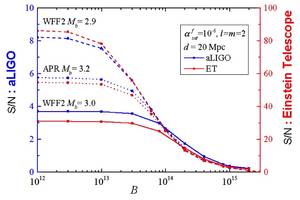Gravitational wave afterglow in binary neutron star mergers

October 2015
Daniela Doneva, Kostas D. Kokkotas, Pantelis Pnigouras
A very massive rapidly rotating star can be formed after binary neutron star merger. In the majority of the cases the star does not have a stable nonrotating limit and it collapses to a black hole after slowing down by a certain amount. Such neutron stars are one of the primary candidates to develop the secular Chandrasekhar-Friedman-Schutz instability, i.e. certain nonaxisymmetric modes of the star can become unstable due to the emission of gravitational waves that may eventually lead to strong gravitational wave signal.
In our studies we focused exactly on such objects and our goal was to check whether the emitted gravitational waves by secularly unstable oscillation modes shortly after the merger can be potentially observed by the next generation of detectors. The results show that indeed the produced gravitational wave signal can be very strong, reaching above the detector’s sensitivity, for moderate and even strong magnetic fields. The event rate will be of the same order as the merging rates, while the analysis of the signal will carry information for the equation of state of the post-merging neutron stars and the strength of the magnetic field.
Phys. Rev. D 92, 104040 (2015), arXiv:1510.00673 [gr-qc]
